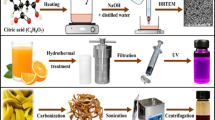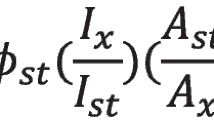Abstract
Waste peels are considered an environmental burden and typically disposed in landfills. The aim of this study was to investigate the effects of various solvents on the luminescence properties of carbon quantum dots (CQDs). Watermelon peels were recycled and reuse as precursors for the synthesis of biomass CQDs via a green carbonization method. The colloidal stability, surface charge, and particle size were characterized using zeta potential and dynamic light scattering (DLS). DLS revealed that the size of the CQDs was approximately 5.80 ± 0.4 nm to 9.74 ± 0.8 nm. The high-resolution transmission electron microscopy (HRTEM) results demonstrated a correlation with the DLS results. The optical properties were characterized by photoluminescence (PL) and UV-Visible (UV-Vis) spectroscopy. PL measurements at different excitation wavelengths revealed that the CQDs emissions were influenced by the polarity of the solvents. Meanwhile, the Fourier transform infra-red (FTIR) results showed the presence of oxygen-containing groups on the surface of the CQDs. These results deepen our understanding of the solvent-dependent behavior and colloidal stability of the CQDs.









Similar content being viewed by others
References
Blachowicz T, Ehrmann A (2020) Recent developments of solar cells from PbS colloidal quantum dots. Appl Sci 10:1743
Pradhan S (2022) Multi-bandgap colloidal quantum dot mixing for optoelectronic devices. New J Chem 46:12892–12900
Zaini MS, Liew JYC, Ahmad SAA, Mohmad AR (2020) Kamarudin, quantum confinement effect and photoenhancement of photoluminescence of PbS and PbS/MnS quantum dots. Appl Sci 10:6282
Xu X, Ray R, Gu Y, Ploehn HJ, Gearheart L, Raker K, Scrivens WA (2004) Electrophoretic analysis and purification of fluorescent single-walled carbon nanotube fragments. J Am Chem Soc 126:12736–12737
Liu J, Li R, Yang B (2020) Carbon dots: a new type of carbon-based nanomaterial with wide applications. ACS Cent Sci 6:2179–2195
Sonsin AF, Nascimento SMS, Albuqurque IMB, Silva ECO, Rocha JCA, Oliveira RS, Barbosa CDA, Souza ST, Fonseca EJS (2021) Temperature-dependence on the optical properties of chitosan carbon dots in the solid state. RSC Adv 11:2767–2773
Cui L, Ren X, Sun M, Liu H, Xia L (2021) Carbon dots: synthesis, properties and applications. Nanomater 11:3419
Li J, Zheng H, Zheng Z, Rong H, Zeng Z, Zeng H (2022) Synthesis of CdSe and CdSe/ZnS quantum dots with tunable crystal structure and photoluminescent properties. Nanomater 12:2969
Zheng S, Chen J, Johansson EMJ, Zhang X (2020) PbS colloidal quantum dot inks for infrared solar cells. iScience 23:101753
Soni H, Sudhakar P (2018) Green Synthesis of N, S co-doped carbon quantum dots from triflic acid treated palm shell waste and their application in Nitrophenol sensing. Mater Res Bull 108:250–254
Atchudan R, Edison TNJI, Shanmugam M, Perumal S, Somanathan T, Lee YR (2020) Sustainable synthesis of carbon quantum dots from banana peel waste using hydrothermal process for in vivo bioimaging, Phys E 114417
Arumugam N, Kim J (2018) Synthesis of carbon quantum dots from broccoli and their ability to detect silver ions. Mater Lett 219:37–40
Ahmadian-Fard-Fini S, Salavati-Niasari M, Ghanbari D (2018) Hydrothermal green synthesis of magnetic Fe3O4-carbon dots by lemon and grape fruit extracts and as a photoluminescence sensor for detecting of E. Coli bacteria, Spec- Trochim. Acta Part A 203:4 81–493
Ventrella A, Camisasca A, Fontana A, Giordani S (2020) Synthesis of green fluorescent carbon dots from carbon nano-onions and graphene oxide. RSC Adv 10(60):36404–36412
Kaczmarek A, Hoffman J, Morgiel J, Moscicki T, Stobinski L, Szymanski Z, Malolepszy A (2021) Luminescent carbon dots synthesized by the laser ablation of graphite in polyethylenimine and ethylenediamine. Materials 14:729
Desai ML, Jha S, Basu H, Singhal RK, Park TJ, Kailasa SK (2019) Acid oxidation of muskmelon fruit for the fabrication of carbon dots with specific emission colors for recognition of Hg2+ ions and cell imaging. ACS Omega 21:19332–19340
Li M, Yu C, Hu C, Yang W, Zhao C, Wang S, Zhang M, Zhao J, Wang X, Qiu J (2017) Solvothermal conversion of coal into nitrogen-doped carbon dots with singlet oxygen generation and high quantum yield. J Chem Eng 320:570–575
Liu R (2021) Facile synthesis of magneto-fluorescent carbon dots by one-step microwave-assisted pyrolysis. J Alloys Compd 855:157456
An Q, Lin Q, Huang X, Zhou R, Guo X, Xu W, Wang S, Xu D, Chang HT (2021) Electrochemical synthesis of carbon dots with a stokes shift of 309 nm for sensing of Fe3+ and ascorbic acid. Dyes Pigm 185:108878
Xian Y, Li K (2022) Hydrothermal synthesis of high-yield red fluorescent carbon dots with ultra-narrow emission by controlled O/N elements. Adv Mater 34:2201031
Aggarwal R, Saini D, Singh B, Kaushik J, Garg AK, Sonkar SK (2020) Bitter apple peel derived photoactive carbon dots for the sunlight induced photocatalytic degradation of crystal violet dye. Sol Energy 197:326–331
Ding H, Zhou X, Qin B, Zhou Z, Zhao Y (2019) Highly fluorescent near-infrared emitting carbon dots derived from lemon juice and its bioimaging application. J Lumin 211:298–304
Mehra S, Khandare SD, Singh K, Chaudhary DR, Kumar A (2023) Ionic liquid capped white luminescent carbon dots: application in sensing and bioimaging. Mater Today Chem 29:101437
Li J, Gong X (2022) One-step large-scale fabricating aggregation-induced emission carbon dots with strong solid-state fluorescence emission. Mater Today Chem 26:101255
Sciortino A, Marino E, Dam BV, Schall P, Cannas M, Messina F (2016) Solvatochromism unravels the emission mechanism of carbon nanodots. J Phys Chem Lett 7:3419–3423
Lin S, Lin C, He M, Yuan R, Zhang Y, Zhou Y, Xiang W, Liang X (2017) Solvatochromism of bright carbon dots with tunable long-wavelength emission from green to red and their application as solid-state materials for warm WLEDs. RSC Adv 7:41552
Yu P, Wen X, Toh YR, Yang J (2012) Temperature-dependent fluorescence in carbon dots. J Phys Chem C 48:25552–25557
Wang H, Sua C, Chen X, Zhang Y, Colvin VL, Rice Q, Seo J, Feng S, Wang S (2017) W. W. U, Excitation wavelength independent visible color emission of carbon dots, Nanoscale 9 1909–1915
Lin H, Jiang K, Sun S, Zhang L, Lu Y, Wu A, Cai C (2015) Red, green, and blue luminescence by carbon dots: full-color emission tuning and multicolor cellular imaging. Angew Commu 54:5360–5363
Lee HJ, Jana J, Ngo YT, Wang LL, Chung JS, Hur SH (2019) The effect of solvent polarity on emission properties of carbon dots and their uses in calorimetric sensors for water and humidity. Mater Res Bull 119:110564
Mohammad-Jafarieh P, Akbarzadeh A, Ahangari RS, Moghaddam MP, Ghaleh KJ (2021) Solvent effect on the absorption and emission spectra of carbon dots: evaluation of ground and excited state dipole moment. BMC Chem 15:53
Huo X, Shen H, Liu R, Shao J (2021) Solvent effects on fluorescence properties of carbon dots: implications for multicolor imaging. ACS Omega 6:26499–26508
Isnaeni Y, Herbani MM, Suliyanti (2018) Concentration effect on optical properties of carbon dots at room temperature. J Lumin 198:215–219
Carbonaro CM, Corpino R, Salis M, Mocci F, Thakkar SV, Olla C, Ricci PC (2019) On the emission properties of carbon dots: reviewing data and discussing models. J Carbon Res 5:60
Li C, Liu W, Sun X, Pan W, Yu G, Wang J (2018) Excitation dependent emission combined with different quenching manners supports carbon dots to achieve multi-mode sensing. Sens Actuators B: Chem 263:1–9
Pandey FP, Rastogi A, Singh S (2020) Optical properties and zeta potential of carbon quantum dots (CQDs) dispersed nematic liquid crystal 4’-heptyl-4-biphenylcarbonitrile (7CB). Opt Mater 105:109849
Bayati M, Dai J, Zambrana A, Rees C, Crotalezzi MFD (2018) Effect of water chemistry on the aggregation and photoluminescence behavior of carbon dots. J Environ Sci 65:223–235
Liu H, Zhao X, Wang F, Wang Y, Guo L, Mei J, Tian C, Yang X, Zhao D (2017) High-efficient excitation-independent blue luminescent carbon dots. Nanoscale Res Lett 12:399
Dager A, Uchida T, Maekawa T, Tachibana M (2019) Synthesis and characterization of mono-disperse carbon quantum dots from fennel seeds: photoluminescence analysis using machine learning. Sci Rep 9:14004
Dong C, Ma X, Huang Y, Zhuang Y, Gao X (2022) Carbon dots nanozyme for anti-inflammatory therapy via scavenging intracellular reactive oxygen species. Front Bioeng Biotechnol 10:943399
Rodhiwok C, Tam TV, Choi WM, Suwannakaew M, Woo SW, Wongratanaphisan D, Kim HS (2022) Preparation and characterization of photoluminescent graphene quantum dots from watermelon rind waste for the etection of ferric ions and cellular bio-imaging applications. Nanomater 12:702
Xie Y, Cheng D, Liu X, Han A (2019) Green hydrothermal synthesis of N-doped carbon dots from biomass highland barley for the detection of Hg2+. Sensors 19:3169
Zhou L, Liu J, Zhang X, Liu R, Huang H, Liu Y, Kang Z (2014) Template-free fabrication of mesoporous carbons from carbon quantum dots and their catalytic application to the selective oxidation of hydrocarbons. Nanoscale 6:5831
Acknowledgements
The authors would like to acknowledge the financial support received from the Fundamental Research Grant Scheme (FRGS) under grant number of (FRGS/1/2023/STG05/UPM/02/3) from the Ministry of Higher Education Malaysia, research grant (GPIPS/2021/9705500) and (UPM-JORDAN/2022/9300486) from Universiti Putra Malaysia.
Funding
This work is supported by Fundamental Research Grant Scheme (FRGS) under grant number of (FRGS/1/2023/STG05/UPM/02/3) from the Ministry of Higher Education Malaysia, research grant (GPIPS/2021/9705500) and (UPM-JORDAN/2022/9300486) from Universiti Putra Malaysia.
Author information
Authors and Affiliations
Contributions
M. S. Zaini: Conceptualization, visualization methodology, investigation, writing–original draft. J. Y. C. Liew: Validation, Data Curation. S. Paiman: Formal analysis and supervision. T. S. Tee: Data Curation, Formal analysis. M. A. Kamarudin: supervision, validation, writing–review and editing, project administration.
Corresponding author
Ethics declarations
Competing Interests
The authors declare that they have no known competing financial interests or personal relationships that could have influenced the work reported in this study.
Ethical Approval
This declaration is not applicable
Additional information
Publisher’s Note
Springer Nature remains neutral with regard to jurisdictional claims in published maps and institutional affiliations.
Rights and permissions
Springer Nature or its licensor (e.g. a society or other partner) holds exclusive rights to this article under a publishing agreement with the author(s) or other rightsholder(s); author self-archiving of the accepted manuscript version of this article is solely governed by the terms of such publishing agreement and applicable law.
About this article
Cite this article
Zaini, M.S., Liew, J.Y.C., Paiman, S. et al. Solvent-Dependent Photoluminescence Emission and Colloidal Stability of Carbon Quantum dots from Watermelon Peels. J Fluoresc (2023). https://doi.org/10.1007/s10895-023-03528-1
Received:
Accepted:
Published:
DOI: https://doi.org/10.1007/s10895-023-03528-1




